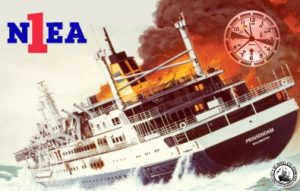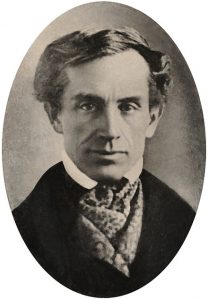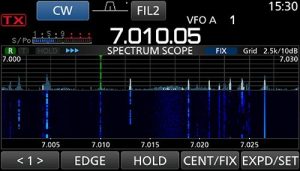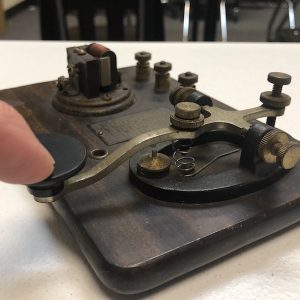Fortieth Anniversary of the MS Prinsedam Rescue at Sea
 David J. Ring, Jr., N1EA, writes on Facebook on October 4, 2020:
David J. Ring, Jr., N1EA, writes on Facebook on October 4, 2020:a field organization of the National Association for Amateur Radio®

 David J. Ring, Jr., N1EA, writes on Facebook on October 4, 2020:
David J. Ring, Jr., N1EA, writes on Facebook on October 4, 2020: Andy Wallace, KA1GTT, writes on the Billerica Amateur Radio Society‘s website:
Andy Wallace, KA1GTT, writes on the Billerica Amateur Radio Society‘s website:
Folks, I am very happy to announce we will have a distant guest speaker for our Zoom meeting [on October 7, 2020 at 7 PM].
A few weeks ago, I was thinking about trying to promote CW in our club and introduce it to members who have never tried it. Google gave me a path to David O’Farrell’s presentations Morse Code 101 and 201. Dave was first licensed as KN7YXO in 1963 (at 15). He was a telegraph operator for the Northern Pacific Railway, holds Amateur Extra and Commercial General Radio Operator licenses, and loves CW! He is also the Treasurer of the Estes Valley Amateur Radio Club in Estes Park, Colorado.
Part of the reason I think BARS should talk more about CW is some of our newer Technician members may not know how much fun they could have with it. Did you know Techs have 650 kHz of CW band space on HF in the 80, 40, 15, and 10 meter bands? (They only get 200 kHz of SSB on 10!) Did you know there are apps and online resources to learn Morse code? And that receiving and sending apps and computer programs exist to help you out? Transceiving CW can be done with much simpler equipment than SSB or even a 2m FM HT. It also cuts through interference and local electrical hash better – you’ll make more contacts. Knowing how to understand CW opens up a whole world of fun operating. The FCC dropped the CW requirement for licensing but you will have a BALL knowing it – just ask any Novice licensee!
Dave sent me a sneak preview of his presentation and it is super. He goes through some very interesting history of Morse code, and digs deep into how to learn it properly. If you already know CW, you will still learn something here. We’ll have time for Q&A and I am sure Dave will elaborate on concepts so anyone new to this world will understand what they will be in for.
Please help me show appreciation for David making time – several time zones away – to present to our club. Let’s have a great turnout for CW 101 and 201.
We will announce the link to join the Zoom meeting before the meeting, but it will be posted to the BARS email list and should not be shared outside our Club. Are you on the email list? If not, please send an email to bars-subscribe@w1hh.org and then simply reply to the robot response from the server and you will be subscribed.
Observing our Zoom meeting requires only a web browser and headphones/speakers. You do not need a webcam or microphone unless you want to speak or be seen.
Before our meeting date, please go to https://zoom.us/test and see if it will function for you. If you have problems, we can try to assist – feel free to ask questions on the BARS email list.
I am looking forward to “seeing” many of you Wednesday 10/7/20.
Andy
KA1GTT
President, Billerica Amateur Radio Society
 On this date in 1840, Samuel Morse received a patent for his “Morse code” system. Morse was a painter, originally. He also studied photography with Louis Daguerre in France, and brought the new technology to America, where he opened a photographic studio in New York City. He became interested in telegraphy after he failed in his bid to become the mayor of New York. During a demonstration of one of his early telegraph machines, he met Alfred Vail, a young mechanical engineer. Vail was fascinated by the telegraph, and he convinced Morse to bring him aboard as an assistant. Vail helped Morse work out some problems with Morse’s original system, and it didn’t hurt that Vail’s father was a wealthy industrialist. Vail put up the money to pay the patent application fees in exchange for a share in whatever resulted.
On this date in 1840, Samuel Morse received a patent for his “Morse code” system. Morse was a painter, originally. He also studied photography with Louis Daguerre in France, and brought the new technology to America, where he opened a photographic studio in New York City. He became interested in telegraphy after he failed in his bid to become the mayor of New York. During a demonstration of one of his early telegraph machines, he met Alfred Vail, a young mechanical engineer. Vail was fascinated by the telegraph, and he convinced Morse to bring him aboard as an assistant. Vail helped Morse work out some problems with Morse’s original system, and it didn’t hurt that Vail’s father was a wealthy industrialist. Vail put up the money to pay the patent application fees in exchange for a share in whatever resulted.
The telegraph works by sending an electromagnetic signal over a wire. Morse had an idea that the current could be used to move a pencil along a moving strip of paper, but Vail simplified it by suggesting a cheaper and more practical alternative: an arm that would bounce up and down. The pair then had to devise a way to convert a tapping arm into a system of language. It was actually Vail, not Morse, who came up with the first dot-and-dash system, with each letter and number being made up of a different combination of long and short sounds or flashes. Vail’s first message using his code was, “A patient waiter is no loser.” But Morse was the better known of the two inventors, and it was his name on the patents, and that’s why we call it “Morse Code” and not “Vail Code.” -From Garrison Keillor’s The Writer’s Almanac, June 20, 2020.
 Andy Wallace, KA1GTT, writes on w1hh.org:
Andy Wallace, KA1GTT, writes on w1hh.org:
I am very pleased to announce that Bruce is returning to speak again at [the Billerica Amateur Radio Society], this time about CW Academy. Many BARS members use and enjoy CW. If you have never tried it, please attend this session and see what is possible for you!
Did I just lose half my audience? I dearly hope not. If you have only used voice your whole ham experience, you are missing out. I promise you will find this talk interesting. Please come and hear why people love operating using Morse code, and the kinds of things you can do once you know it. [Full story]
 Are you interested in learning Morse code? Have you heard it on the air or as part of a movie? Learn to copy and send all the letters, numbers, punctuation, and pro-signs in only eight weeks. Register for an introductory Morse code class at New England Sci-Tech, 16 Tech Circle, Natick.
Are you interested in learning Morse code? Have you heard it on the air or as part of a movie? Learn to copy and send all the letters, numbers, punctuation, and pro-signs in only eight weeks. Register for an introductory Morse code class at New England Sci-Tech, 16 Tech Circle, Natick.
Saturday mornings, from 9:00-10:30 a.m. starting June 29, 2019. Dates: June 29, July 6, 13, 20, 27, Aug 3, 10, 17.
Full details at https://www.nescitech.org/product/introductory-morse-code-class/.